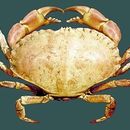Diagnostic Description
provided by FAO species catalogs
Body broadly oval, rather conex, grooves very faint. Front with 5 blunt teeth, not produced beyond outline of carapace; anterolateral margin with 9 wide, blunt teeth with rounded tops, separated by closed fissures. Pincers large and smooth, without spinules; last four pairs of legs similar, roughened by numerous groups of very short stiff black hairs, but without true spines or spinules. Colour pale reddish brown, at places more yellowish brown, juveniles more purplish; colour more or less uniform, without a special pattern; tips of fingers of chelae black.
- Fischer, W.; G. Bianchi; W. B. Scott (eds.).- 1981. Fiches FAO d'identification des espèces pour les besoins de la pêche. Atlantique centre-est; zones de pêche 34, 47 (en partie).Canada Fonds de Dépôt. Ottawa, Ministère des Pêcheries et Océans Canada, en accord avec l'Organisation des Nations Unies pour l'Alimentation et l'Agriculture, Vol. 1-7: pag. var.
- Lloris, D. & J. Rucabado.- 1998. Guide FAO d'Identification des espèces pour les besoins de la pêche. Guide d'Identification des Ressources Marines Vivantes du Maroc. Rome, FAO 263 pp.
- Zariquiey, R.- 1968. Crustáceos decápodos Ibéricos.Inv. Pesq. 32. 510 pp.
Distribution
provided by FAO species catalogs
Eastern Atlantic, from the northern Morocco extending along the Atlantic coast of Europe, to the Bristish Isles and northern Norway (about 70º N); several, but mostly old, records from the north coast of the Mediterranean (Marseille, Napoli, Greece).
Size
provided by FAO species catalogs
Maximum carapace length 20 cm; maximum carapace width 30 cm. Usually the carapace width does not surpass 24 cm.
Brief Summary
provided by FAO species catalogs
Benthic, lives on a wide range on bottoms of sand, gravel and rocky,in depths of 6 to100 m; usually between 6 and 40 m depth.
Benefits
provided by FAO species catalogs
It is a moderately important, caught usually with traps (in Europe); also as by catch in trawl fisheries. The total catch reported for this species to FAO for 1999 was 41 337 t. The countries with the largest catches were UK (19 988 t) and France (8 498 t). Marketed fresh and frozen.

